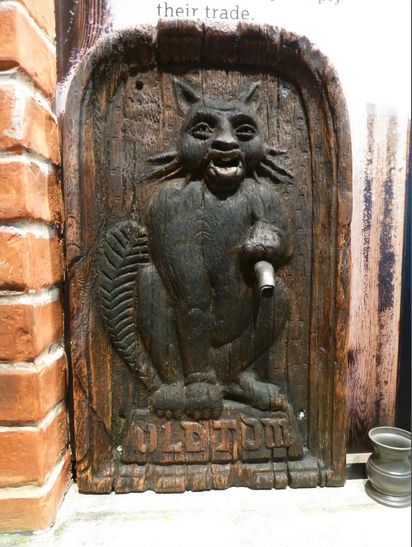
I learned this today. Gin was sold from a cat in London in 1739 because Captain Dudley Bradstreet found a loophole in the 1736 Gin Act.
Between 1690 and 1751, England went through a period of high consumption of gin. In 1743, it was estimated that people were drinking an average of 10 liters of gin per person per year and there were supposed to be over 7,000 gin shops in London. A variety of social commentators said that the “gin craze” was destroying England. William Hogarth drew his famous prints “Gin Lane” and “Beer Street”. It compares the consumption of gin to beer. The gin drinkers are shown as debauched and hopeless. The beer drinkers are shown as healthy and thriving.
Gin was invented in Southern France and Holland in the 13th century. It was made by monks and was seen as a medicine. It came to England in the early 17th century and became popular when William of Orange from Holland became King William III of England. The word “gin” comes from the Dutch word “jenever”, which in turn came from the juniper berry that was added to give the gin its flavor.
There were a few reasons why the consumption of gin took off at the end of the 17th century. Firstly, there was a drop in food prices at this time. This was partly due to the Agricultural revolution that was happening in England, which meant that, for possibly the first time, more food could be produced than was needed. This caused food prices to drop and meant that working class people had a small disposable income that they could spend on alcohol.
Secondly, Britain had been at war with France off and on, and brandy, the usual drink, had become unpatriotic and unfashionable. People looked for a more British drink. Gin, despite being from Holland, was now made in the UK and was “British”.
Thirdly, Parliament passed several laws to increase the production of British gin and tax French brandy imports.
Gin started to grow in popularity. In the beginning, it copied the Dutch style and wasn’t overly strong: possibly 30%. However, as more places in London started to distill it, and as it was mixed with more and more unsavory things, it grew in potency. There were tales told of people who went blind drinking gin in some of the less reputable gin houses.
In the beginning, no licenses were required to distill spirits and there were reduced taxes to encourage the production. The government’s plan worked too well and within 40 years the gin craze had well and truly taken hold.
At the start of the 18th century, there was an increase in urbanization. People moved to London, but soon realized there were very few jobs. The poor started to drink the cheap gin and there was a tremendous moral panic by the richer elements of society.
The government decided to do something and introduced the Gin Act of 1736. This taxed gin and brought in expensive licenses to sell gin, which nobody bought. There were riots against this law. The law made it illegal to sell gin in large quantities and paid people to inform on anyone who sold too much gin or illegal gin. Selling gin became difficult. This law resulted in a huge amount of underground gin, and it also resulted in the gin cat.
In 1739, Captain Dudley Bradstreet, (he may very well have given himself the title of “Captain”) travelled from Ireland to London. He had no money and needed to make some. He started by informing on people selling gin, but then he had another idea. He read the Gin Act of 1736 and realized there was a loophole. The authorities had no right to break into a house if it was locked, even if they knew gin was being sold there, and to inform on someone selling gin it was necessary to know the name of the person who was renting the premises. He found a way to use this information. He had an acquaintance rent a house and Dudley sublet it. That way no one would be able to find out who was renting the house. He used the last of his money to buy gin and filled his house with food to last days. He found a wooden sign with a cat on it at a local market. He built a pipe into it, installed it in his window, and locked himself in his house. When a customer put a coin in the cat’s mouth, Dudley would pour a measure of gin down the pipe and the customer would catch it in a cup (I presume) or just drink it from the pipe. Dudley’s gin cat became popular, and queues of people formed. The neighbors complained, but the authorities couldn’t do anything because they couldn’t knock the doors down and they didn’t know who was renting the house.
In about 3 months, Dudley made the equivalent of $13,000 today, but imitators soon popped up and his business fell. He gave it up and, after trying a few other ventures, became a spy for the Duke of Cumberland.
The gin craze continued until the Gin Law of 1751. The writers of this law had learned their lesson and it was more reasonable. It lowered license fees and encouraged the distillers of good gin. However, this act was probably not the reason that the gin craze ended. Just as it started with low food prices, it ended when food prices went back up. By 1751, the price of grain was rising, there had been a series of poor harvests, an increased population meant lower wages, and food prices were increasing. People could no longer afford to drink gin. And this is what I learned today.
Photo By https://www.iceandaslice.co.uk/blogs/news/where-does-the-cat-symbol-on-gin-originate
Sources
https://en.wikipedia.org/wiki/Gin_Craze
https://en.wikipedia.org/wiki/Dudley_Bradstreet
https://londonist.com/london/drink/london-s-gin-dispensing-cat
https://www.diffordsguide.com/g/1108/gin/old-tom-gin
https://www.pastemagazine.com/drink/alcohol-history/the-gin-craze-britain-1700s/
https://www.vice.com/en/article/53jj7z/how-a-gin-craze-nearly-destroyed-18th-century-london
https://en.wikipedia.org/wiki/Beer_Street_and_Gin_Lane
https://en.wikipedia.org/wiki/Gin
